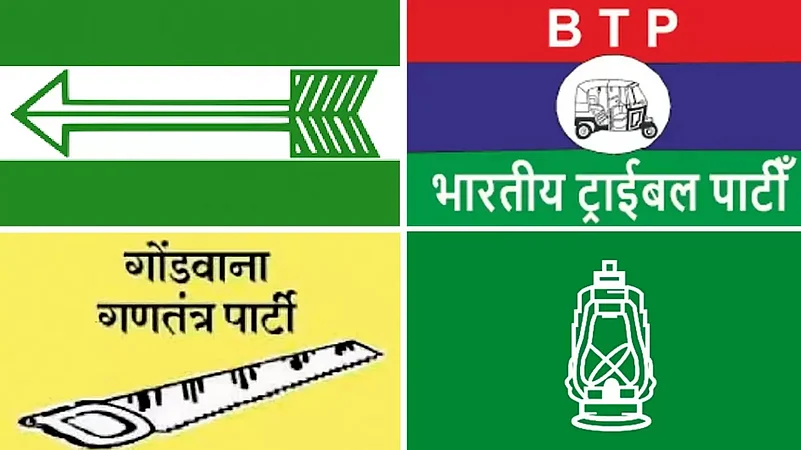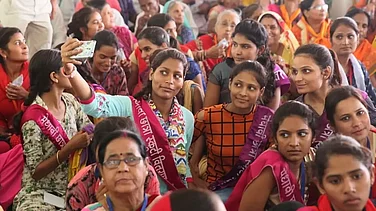“History repeats itself, first as
tragedy, the second time as farce”
—Karl Marx
Bijapur resident, activist and first-time Vidhan Sabha candidate Ashok Talandi couldn’t sleep the night before the election results. Most exit polls had predicted a return of the Congress in Chhattisgarh. On the ground though, Talandi, fighting the elections under the newly-formed Hamar Raj Party (HRP), knew that change was in the air and even felt hopeful. For the last two years, Bijapur had seen massive anti-incumbency and Adivasi protests against the sitting Congress MLA, Vikram Mandavi. And the Congress appeared to be losing ground in several tribal seats. Could Talandi, who had been campaigning about Adivasi rights and PESA implementation, have an actual shot? After all, the BJP candidate, Mahesh Gagde, not unlike him, came from a social-work background and had a “clean image”, but no political clout. A few rounds of counting, however, were enough for Talandi to feel that he hadn’t made it. Mandavi eventually won the seat after a close contest with the BJP, with just over 2,000 votes. “Despite the BJP not having a strong face and Congress’ MLAs facing anti-incumbency, the fight became bipolar. The other candidates, despite being locally popular, barely got any votes, which means that voters did not vote for the candidate, but the party,” he says.
Talandi’s dejection matches that of hundreds of candidates who had been fighting elections independently, under regional parties or smaller banners. Among the 90 seats in Chhattisgarh, just one seat managed to go beyond the Congress-BJP binary and was won by the Gondwana Ganatantra Party, even as the BJP won 54. The HRP, which contested nearly 50 seats and even appeared to be leading initially in the Khujji seat, was completely routed. Regional players faced the same fate in other parts of Chhattisgarh, Madhya Pradesh, Rajasthan and Telangana, where they failed to make a dent in the BJP’s vote bank, though they did eat into the Congress’ votes in some seats.
In the run-up to the crucial 2024 elections, the current election trends may be indicative of not just the BJP’s dominance in the Hindi belt, but also of a shift in the country’s party system: from a multi-party coalition era to one-party dominance at the Centre and bipolarity in the states.

Looking Back
Soon after the BJP’s resounding win in the three Hindi heartland states, the over two dozen parties, which make up the Indian National Developmental Inclusive Alliance (INDIA) opposition bloc, sprang into action. From firm statements against the Congress to cancelled bloc meetings, parties that had come together to fight the BJP in the upcoming 2024 Lok Sabha elections appeared united in their criticism of the Congress, which hitherto headed the bloc. “Had the INDIA bloc fought the elections united with its allies, the results would have been different,” a spokesperson of the JD(U) quipped. But would they? To what extent can regional parties shape the political narrative today? While the INDIA allies have been quick to blame the Congress, regional parties have been in a crisis since 2014, when the BJP came to power with a landslide majority, signalling a new, yet familiar shift in the party system in India.
From 1947 to 1967, India unofficially followed what is called the “Congress system” where one party dominated at the centre as well as the states. The first shift in India’s party system came in 1967 after the Congress lost eight state elections. From then on, the Congress remained dominant at the Centre, but started facing stiffer competition from other parties in the states.
In 1989, the electoral system in India took a decisive turn with the beginning of the fragmented, multi-party system and coalition governments, and within a decade, the system crystallised into a binodal system of “two national alliances”—the BJP-led National Democratic Alliance and the Congress-led United Progressive Alliance. In 2009, political observers noted another shift in the trend when the Congress improved its own seat share by 37 per cent. Nevertheless, for some time, it was impossible for any party, including the Congress, to imagine forming a government on its own.
This system changed once again, and this time drastically in 2014. At the time, political scientists waited to see whether this was an aberration or whether it marked the beginning of a new trend. Ten years into the Modi Sarkar, the BJP now rules 12 out of 28 states and is a coalition partner in four more. The trends are unmistakable.
“It seems that we are going back to a system where we have one dominant party, but instead of the Congress, it is now the BJP,” says Zaad Mahmood, political science researcher at Presidency University, West Bengal.

Seats Vs Votes
Several factors have contributed to this shift in the party system, which seems to have come more at the cost of regional parties than the Congress. In three key states where the Congress recently lost, its loss in seats was not proportionate to its loss in vote share. In fact, the Congress secured 4.9 crore votes in the five states that went to polls against the BJP’s tally of 4.81 crore votes. The BJP won despite polling less total votes. On the other hand, Mayawati’s BSP, which contested polls independently in Rajasthan and Telangana and jointly with the Gondwana Ganatantra Party (GGP) in Madhya Pradesh and Chhattisgarh, failed to open its account in three of these states. It won two seats in Rajasthan, even as it registered a drop in its votes and seats in MP and Chhattisgarh.
Of the 98 SC-reserved assembly constituencies in these four states, the BJP won 57, while the Congress managed to clinch 40. In 2018, the BJP won 32 of these seats and the Congress, 45. Despite the Congress holding on to some bastions in the Congress belts, the BJP has been consistently performing well in these seats, again at the cost of regional parties or independent candidates. Incidentally, the entry of other regional parties in many states—which have previously seen bipolar fights between the Congress and the BJP or locally dominant parties—has also worked in favour of the BJP, as these parties not only cut into the Congress’ vote share but also harmed the electoral performance of smaller local parties or independent candidates.
Be it in the tribal belts of Gujarat, Chhattisgarh or Madhya Pradesh, local alternatives for tribal voters have consistently been reducing, with voters having to choose between the Congress and the BJP. In Chhattisgarh, the BJP secured 17 of the 29 tribal seats this time, and 27 of the 47 tribal seats in Madhya Pradesh. In Gujarat last year, the BJP won a whopping 23 of the 27 tribal seats, unseating major regional players like seven-time MLA Chhotubhai Vasava of the locally-influential Bharatiya Tribal Party (BTP).
“Recent election results have shown that the regional parties are taking over the Congress vis-à-vis the BJP, as we have seen in Delhi, Odisha and West Bengal. Even in those states where the fight was earlier between two regional parties, now the regional parties will have to fight the BJP as has been the case in Uttar Pradesh,” says political scientist Narayana A, associate professor at the School of Policy and Governance at Azim Premji University, Bengaluru. He predicts a similar fate for some of the southern states if the present trends continue.
“The present vote share trend suggests that it (sidelining of regional parties) will eventually happen in southern states such as Telangana and Tamil Nadu as well,” he says. The strike rate of the BJP against the regional parties is higher than the Congress’s strike rate against the regional parties. The sole exception this time is Telangana, where the Congress has defeated a regional party after a long time. “The BJP is nevertheless growing and how its growth would affect the BRS is difficult to guess at the moment,” adds Narayana.
National Aspirations, Hyper-local Politics
In India, the rise of regional parties represents a complex history of diversity and balance. Foregrounded by caste, class, religious, linguistic and other social stratifications, regional parties in a federal democracy like India remain important not only because they represent diverse communities, but also because they act as checks on the political monopoly. If it weren’t for regional parties, it is safe to argue that the Congress’ hold over the nation would never have weakened.
While enforcing a balance of power, one of the major roles of regional parties was to ensure that the region or the people they represent get more voice and visibility at the centre. Explaining the rise of the BJP in the states, Mahmood explains that the party has essentially been reimagining social groups at the grassroots level and aligning them with a larger “national” identity to engineer electoral wins. This reimagining goes beyond the popular Hindu-Muslim narrative that the party or the media often want to peddle.
“The BJP understands that no identity is homogenous. Even among Muslims, who are projected as a homogenous political rhetoric by the BJP, the party tries to find faultiness like oppression of Pasmanda Muslims to attract voters,” explains Mahmood.
These constant and meticulous permutations and combinations that can work towards weaning away voter segments—small or big—from regional or national parties is a hallmark of the BJP which draws ideological support and physical backing from Sangh Parivar organisations. In the tribal belts of Bastar in Chhattisgarh, for instance, organisations dominated by far-right ideologues have allegedly worked to mobilise hate and further communal divides between indigenous/Hindu Adivasis and Christian Adivasis. The past two years have seen several incidents of religious polarisation, something which the Congress government in the state failed to take into account. The BJP used a similar strategy in Gujarat in the 1990s and it continues to be a part of their messaging in those belts.
To break the BJP’s increasing hold on the tribal vote, former Congress veteran and tribal leader Arvind Netam, who floated the HRP, says that minority communities such as Adivasis can never be truly represented as long as the Congress and the BJP remain in power.
“The intention of starting a new party was to try and create a space in politics for Adivasis beyond the parties that do not reflect Adivasi narratives at the Centre despite having Adivasi candidates,” he says. Locals in Bastar, however, told Outlook ahead of the elections that any new party at this point would have to be patient and start from the ground up. “No small party can form a majority in any state right now, so we have to align with parties or candidates who represent us the most at the Centre,” says Sarva Adivasi Samaj member Sunil Ursa in Bastar.
Similar patterns can be observed in northeastern states, where the BJP had earlier been invisible but has increasingly grown since 2014. In Nagaland, for instance, the BJP has benefited from divisions between eastern and western Naga tribes and has been unofficially supporting the demand for a separate “Eastern Nagaland Frontier” or a state within state as a way to break the united demand for Naga nationhood against the Centre. Speaking to Outlook in the run-up to the state elections last year (which the BJP won), local tribal body Chang Khulei Shetshang’s president, Nungsanglemba Chang from Tuensang, a neglected district in Nagaland, had said, “For the last two terms, the Congress has not won and is likely to lose again. We do not support the political ideology of the BJP, but we have to align with those in power at the Centre in order to negotiate more funds for development and infrastructure for the state.” In Manipur, the BJP has benefited by exploiting existing fissures between the two dominant groups, the Kukis and the Meiteis, and aligned itself with the more politically powerful group.
Survival Strategies
The recent elections were not a total loss for independent or regional politics. In Rajasthan, the Bharat Adivasi Party (BAP) has emerged as a winner in some tribal seats and has decided to remain in the opposition. A surprise victory for regional parties came from Mizoram where a relatively new and people-driven Zoram People’s Movement (ZPM), managed to poll a majority of the votes. An analysis of votes polled in Madhya Pradesh shows that while the BJP and the Congress remained dominant, “third parties”, including the BSP, the SP, the GGP and independents, won a total of 27 seats. While the parties’ individual performances may have suffered, the “Third Front” needs to be reckoned with. Moreover, regional stalwarts such as Mayawati, Akhilesh Yadav, Mamata Banerjee, Nitish Kumar and Sharad Pawar remain the leading power brokers of contemporary politics, and the BJP’s track record against regional parties in the south has not been glowing. Kumar has even managed to challenge the BJP’s hold among OBC voters by announcing the caste census.
Nevertheless, the overall precedence of the BJP across the Hindi heartland states seems to have jolted regional parties, including the ones that are part of the INDIA alliance, possibly forcing them to rethink their strategy. Their criticism of the Congress’ way of forging alliances indicates that regional parties are slowly becoming aware that while they may not be able to beat the BJP, they may be able to beat the Congress within the alliance with the latter lacking local-level leadership or organisational strength that the regional parties already have. This gives them greater room to bargain when it comes to seat-sharing arrangements. The other option, of course, is allying with the party in power and becoming a local power broker.
Mahmood says that at this juncture, with a dominant BJP and a failing Congress, regional parties have to strategise ways to stay in power, if not at the centre than at least in their respective states. “No matter how popular a party or a leader is locally, they will have to consider the possibility of allying with the winning party, especially if the latter wins three times in a row,” says Mahmood.
While the power to form strategic alliances might give regional parties the potential power to play kingmaker, analysts claim that parties should remain wary. “Once the BJP comes to power, it becomes difficult to dislodge it. The party seems to be increasingly anti-incumbency-proof, as is the case in Gujarat, Madhya Pradesh, Haryana and Uttarakhand. Should this happen in the states where the regional parties now fight the BJP, then the regional parties will have to go through a prolonged period without power. Under such circumstances, they will find it difficult to sustain themselves,” explains Narayana.
Additionally, when it comes to alliances, the opposition faces another challenge which the BJP has perfected—ideological unity. The lack of a common ideology impacts voter psyche and a visible example of the same could be gleaned from the Sanatana vote controversy that unfolded in the run-up to the recent elections. The controversy left a large section of Hindus across the country—be it the BJP or the Congress supporters—miffed, and may have been a reason for the failure of the “soft Hindutva” tactics the INDIA bloc was espousing in these states.
“Just as the Congress is, most regional parties—with possible exceptions such as DMK—are individual-centric sans a clear ideology, which will make it difficult for them to fight the BJP, which is increasingly drawing its strength from the ideology, more than anything else,” says Narayana. In the aftermath of election results last week, many analysts attributed the swing in the Congress votes to the BJP as a direct response to the INDIA alliance’s disparate attitude to the controversy.
In order to appear as a reliable front against the BJP at a state level, regional parties—both opposing or allies—need to decide whether they want to stay with the party at the centre to broker power at the state level or win power independently in the state elections to negotiate their position within the larger national narrative at the centre.
(This appeared in the print as 'End Of An Era?')


























